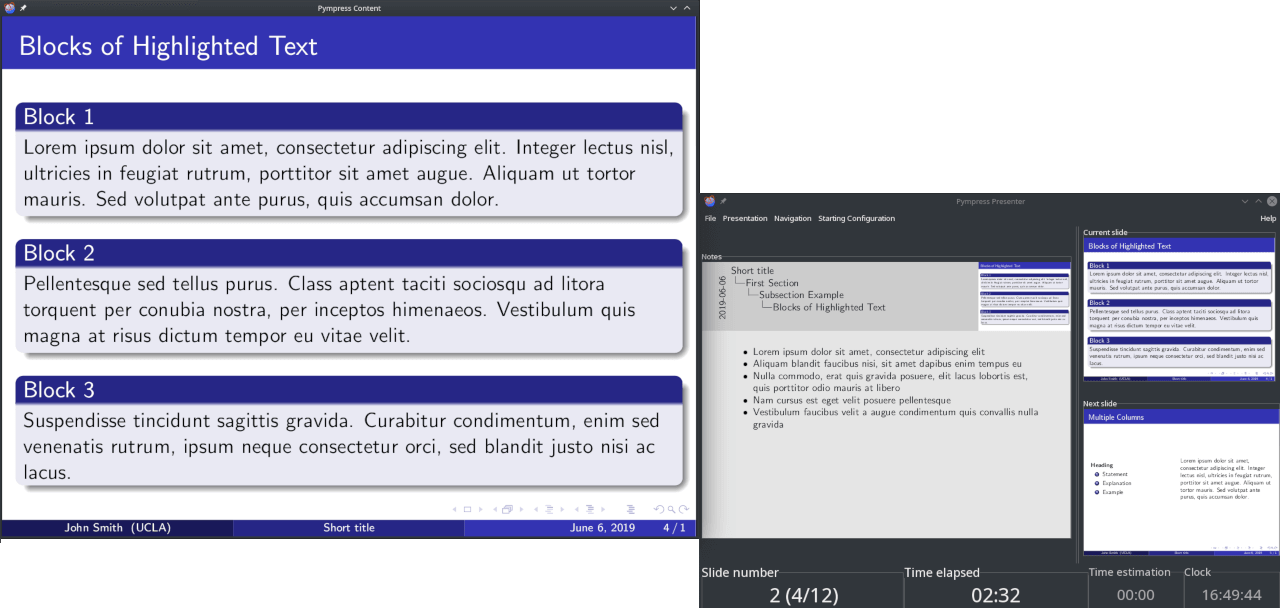
Research
/Security News
Malicious npm Packages Target WhatsApp Developers with Remote Kill Switch
Two npm packages masquerading as WhatsApp developer libraries include a kill switch that deletes all files if the phone number isn’t whitelisted.
 What is Pympress?
What is Pympress?Pympress is a PDF presentation tool designed for dual-screen setups such as presentations and public talks. Highly configurable, fully-featured, and portable
It comes with many great features (more below):
Pympress is a free software, distributed under the terms of the GPL license (version 2 or, at your option, any later version).
Pympress was originally created and maintained by Schnouki, on his repo.
Here is what the 2 screen setup looks like, with a big notes slide next to 2 small slides (current and next) on the presenter side:

Simply start Pympress and it will ask you what file you want to open.
You can also start pympress from the command line with a file to open like so:
pympress slides.pdf
or
python3 -m pympress slides.pdf
All functionalities are available from the menus of the window with slide previews. Don't be afraid to experiment with them!
Keyboard shortcuts are also listed in these menus. Some more usual shortcuts are often available, for example Ctrl+L, and F11 also toggle fullscreen, though the main shortcut is just F.
A few of the fancier functionalities are listed here:
Two-screen display: See on your laptop or tablet display the current slide, the next slide, the talk time and wall-clock time, and annotations (either PDF annotations, beamer notes on second slide, or Libreoffice notes pages). The position of the beamer or Libreoffice notes in the slide is detected automatically and can be overridden via a menu option.
If you do not want to use second-slide beamer notes but prefer to have notes on their own pages, you can enable auto-detection of these notes.
Use the following snippet that prefixes the page labels with notes: on notes pages:
\addtobeamertemplate{note page}{}{\thispdfpagelabel{notes:\insertframenumber}}
Media support: supports playing video, audio, and gif files embedded in (or linked from) the PDF file, with optional start/end times and looping.
Highlight mode: Allows one to draw freehand on the slide currently on screen.
Go To Slide: To jump to a selected slide without flashing through the whole presentation on the projector, press G or click the "current slide" box.
Using J or clicking the slide label will allow you to navigate slide labels instead of page numbers, useful e.g. for multi-page slides from beamer \pause.
A spin box will appear, and you will be able to navigate through your slides in the presenter window only by scrolling your mouse, with the Home/Up/Down/End keys,
with the + and - buttons of the spin box, or simply by typing in the number of the slide. Press Enter to validate going to the new slide or Esc to cancel.
Deck Overview: Pressing D will open an overview of your whole slide deck, and any slide can be opened from can simply clicking it.
Software pointer: Clicking on the slide (in either window) while holding ctrl down will display a software laser pointer on the slide. Or press L to permanently switch on the laser pointer.
Talk time breakdown: The Presentation > Timing Breakdown menu item displays a breakdown of how much time was spent on each slide, with a hierarchical breakdown per chapters/sections/etc. if available in the PDF.
Automatic file reloading: If the file is modified, pympress will reload it (and preserve the current slide, current time, etc.)
Big button mode: Add big buttons (duh) for touch displays.
Swap screens: If Pympress mixed up which screen is the projector and which is not, press S
Automatic full screen: pympress will automatically put the content window fullscreen on your non-primary screen when:
Estimated talk time: Click the Time estimation box and set your planned talk duration. The color will allow you to see at a glance how much time you have left.
Adjust screen centering: If your slides' form factor doesn't fit the projectors' and you don't want the slide centered in the window, use the "Screen Center" option in the "Presentation" menu.
Resize Current/Next slide: You can drag the bar between both slides on the Presenter window to adjust their relative sizes to your liking.
Caching: For efficiency, Pympress caches rendered pages (up to 200 by default). If this is too memory consuming for you, you can change this number in the configuration file.
Configurability: Your preferences are saved in a configuration file, and many options are accessible there directly. These include:
See the configuration file documentation for more details,
Editable PDF annotations: Annotations can be added, removed, or changed, and the modified PDF files can be saved
Automatic next slide and looping
-h, --help: Shows a list of all command line arguments.-t mm[:ss], --talk-time=mm[:ss]: The estimated (intended) talk time in minutes and optionally seconds.-n position, --notes=position: Set the position of notes on the pdf page (none, left, right, top, bottom, or after). Overrides the detection from the file.--log=level: Set level of verbosity in log file (DEBUG, INFO, WARNING, ERROR).To enable media playback, you need to have either:
libgstgtk) which is sometimes packaged separately (e.g. as gst-plugin-gtk or gstreamer1.0-gtk3), and plugins gstreamer-good/-bad/-ugly based on which codecs you need, orenabled = on under the [vlc] section of your config file.On macOS, issues with the gstreamer brew formula may require users to set GST_PLUGIN_SYSTEM_PATH manually. For default homebrew configurations the value should be /opt/homebrew/lib/gstreamer-1.0/. Make sure to set this environmental variable globally, or pympress might not pick it up.
To produce PDFs with media inclusion, the ideal method is to use beamer’s multimedia package, always with \movie:
\documentclass{beamer}
\usepackage{multimedia}
\begin{frame}{Just a mp4 here}
\centering
\movie[width=0.3\textwidth]{\includegraphics[width=0.9\textwidth]{frame1.png}}{movie.mp4}
\movie[width=0.3\textwidth]{}{animation.gif}
\movie[width=0.3\textwidth]{}{ding.ogg}
\end{frame}
If you desire autoplay, ensure you have pympress ≥ 1.7.0 and poppler ≥ 21.04, and use the movie15 package as follows:
\documentclass{beamer}
\usepackage{movie15}
\begin{document}
\begin{frame}
\begin{center}
\includemovie[attach=false,autoplay,text={%
\includegraphics{files/mailto.png}%
}]{0.4\linewidth}{0.3\linewidth}{files/random.mpg}
\end{center}
\end{frame}
\end{document}
Pympress relies on:
typelib-1_0-Poppler-0_18 on OpenSUSE, gir1.2-poppler-0.18 on Ubuntu)The dependencies are often installed by default, or easily available through your package or software manager. For example, on ubuntu, you can run the following as root to make sure you have all the prerequisites assuming you use python3:
apt-get install python3 python3-pip libgtk-3-0 libpoppler-glib8 libcairo2 python3-gi python3-cairo python3-gi-cairo gobject-introspection libgirepository-1.0-1 libgirepository1.0-dev gir1.2-gtk-3.0 gir1.2-poppler-0.18
Different distributions might have different package naming conventions, for example the equivalent on OpenSUSE would be:
zypper install python3 python3-pip libgtk-3-0 libpoppler-glib8 libcairo2 python3-gobject python3-gobject-Gdk python3-cairo python3-gobject-cairo typelib-1_0-GdkPixbuf-2_0 typelib-1_0-Gtk-3_0 typelib-1_0-Poppler-0_18
On CentOS/RHEL/Fedora the dependencies would be:
yum install python36 python3-pip gtk3 poppler-glib cairo gdk-pixbuf2 python3-gobject python3-cairo
And on Arch Linux:
pacman -S --needed python python-pip gtk3 poppler cairo gobject-introspection poppler-glib python-gobject gst-plugin-gtk
Dependencies can be installed using Homebrew:
brew install --only-dependencies pympress
The binary installer for windows comes with pympress and all its dependencies packaged.
Alternately, in order to install from pypi or from source on windows, there are two ways to get the dependencies:
using MSYS2 (replace x86_64 with i686 if you're using a 32 bit machine).
Warning: this can take a substantial amount of disk size as it requires a full software distribution and building platform.
pacman -S --needed mingw-w64-x86_64-gtk3 mingw-w64-x86_64-cairo mingw-w64-x86_64-poppler mingw-w64-x86_64-python3 mingw-w64-x86_64-vlc python3-pip mingw-w64-x86_64-python3-pip mingw-w64-x86_64-python3-gobject mingw-w64-x86_64-python3-cairo
This is also the strategy used to automate builds on appveyor.
Using PyGobjectWin32. Be sure to check the supported Python versions (up to 3.4 at the time of writing), they appear in the FEATURES list in the linked page.
Alternately, you can build your Gtk+3 stack from source using MSVC, see the Gnome wiki and this python script that compiles the whole Gtk+3 stack. This strategy has not been used successfully yet, due to problems building Poppler with its introspection bindings (i.e. typelib) − see #109.
Feel free to clone this repo and use it, modify it, redistribute it, etc, under the GPLv2+. A number of contributors have taken part in the development of pympress and submitted pull requests to improve it.
Be respectful of everyone and keep this community friendly, welcoming, and harassment-free. Abusive behaviour will not be tolerated, and can be reported by email at me@cimba.li − wrongdoers may be permanently banned.
Pympress has inline sphinx documentation (Google style, contains rst syntax), and the docs generated from it are hosted on the github pages of this repo.









We thank the many contributors of translations: Agnieszka, atsuyaw, Cherrywoods, Dirk Herrmann, Dongwang, Estel-f, Fabio Pagnotta, Ferdinand Fichtner, Frederik. blome, FriedrichFröbel, GM, He. yifan. xs, Jaroslav Svoboda, Jeertmans, Johannchristensen, Kristýna, lazycat, Leonardo Biason, Leonvincenterd, LogCreative, Lorenzo. pacchiardi, Luis Sibaja, Marcin Dohnalik, marquitul, Morfit, Mzn, Nico, Ogawa, Paul, Pierre BERTHOU, polaksta, Saulpierotti, Shebangmed, Stanisław Polak, susobaco, Tadashi Saito, Tapia, Tejas, Timo Zhang, Tkoyama010, Toton95, Vojta Netrh, Vulpeculus, and Cimbali.
If you also want to add or contribute to a translation, check pympress’ page on POEditor.
Note that old strings are kept and tagged removed, to give context and keep continuity between translations of successive versions.
This means removed strings are unused and do not need translating.
Official releases are made to PyPI and with github releases. The community maintains a number of other packages or recipes to install pympress (see Install section). Any additions welcome.
FAQs
A simple and powerful dual-screen PDF reader designed for presentations
We found that pympress demonstrated a healthy version release cadence and project activity because the last version was released less than a year ago. It has 1 open source maintainer collaborating on the project.
Did you know?

Socket for GitHub automatically highlights issues in each pull request and monitors the health of all your open source dependencies. Discover the contents of your packages and block harmful activity before you install or update your dependencies.

Research
/Security News
Two npm packages masquerading as WhatsApp developer libraries include a kill switch that deletes all files if the phone number isn’t whitelisted.

Research
/Security News
Socket uncovered 11 malicious Go packages using obfuscated loaders to fetch and execute second-stage payloads via C2 domains.

Security News
TC39 advances 11 JavaScript proposals, with two moving to Stage 4, bringing better math, binary APIs, and more features one step closer to the ECMAScript spec.